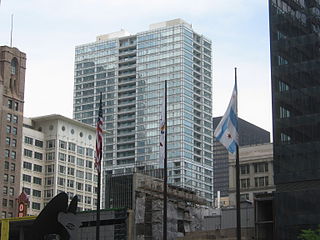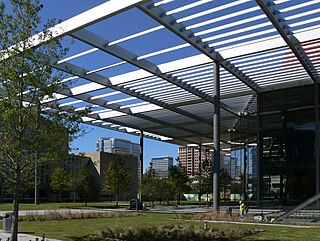
Dankmar Adler was a German-born American architect and civil engineer. He is best known for his fifteen-year partnership with Louis Sullivan, during which they designed influential skyscrapers that boldly addressed their steel skeleton through their exterior design: the Wainwright Building in St. Louis, Missouri (1891), the Chicago Stock Exchange Building (1894), and the Guaranty Building in Buffalo, New York (1896).

The Royal Opera House (ROH) is a historic opera house and major performing arts venue in Covent Garden, central London. The large building is often referred to as simply Covent Garden, after a previous use of the site. It is the home of The Royal Opera, The Royal Ballet, and the Orchestra of the Royal Opera House. The first theatre on the site, the Theatre Royal (1732), served primarily as a playhouse for the first hundred years of its history. In 1734, the first ballet was presented. A year later, the first season of operas, by George Frideric Handel, began. Many of his operas and oratorios were specifically written for Covent Garden and had their premieres there.

Lyric Opera of Chicago is one of the leading opera companies in the United States. It was founded in Chicago in 1954, under the name 'Lyric Theatre of Chicago' by Carol Fox, Nicola Rescigno and Lawrence Kelly, with a season that included Maria Callas's American debut in Norma. The company was re-organized by Fox in 1956 under its present name and, after her 1981 departure, it has continued to be of one of the major opera companies in the United States. The Lyric is housed in a theater and related spaces in the Civic Opera Building. These spaces are now owned by the Lyric.

The Auditorium Building in Chicago is one of the best-known designs of Louis Sullivan and Dankmar Adler. Completed in 1889, the building is located at the northwest corner of South Michigan Avenue and Ida B. Wells Drive. The building was designed to be a multi-use complex, including offices, a theater, and a hotel. As a young apprentice, Frank Lloyd Wright worked on some of the interior design.

Ferdinand Wythe Peck (1848-1924) was a wealthy Chicago, Illinois, businessman and philanthropist, best known for financing Chicago's Auditorium Building.

Marion Oliver McCaw Hall is a performing arts hall in Seattle, Washington. Located on the grounds of Seattle Center and owned by the city of Seattle, McCaw Hall's two principal tenants are the Seattle Opera and Pacific Northwest Ballet. The building is named for Marion Oliver McCaw, whose four sons donated $20 million to fund a major renovation in 2003. It was formerly known as the Civic Auditorium and Seattle Opera House.

The Joffrey Ballet is an American dance company and training institution in Chicago, Illinois. The Joffrey regularly performs classical and contemporary ballets during its annual performance season at the Civic Opera House, including its annual presentation of The Nutcracker.

Buxton Opera House is in The Square, Buxton, Derbyshire, England. It is a 902-seat opera house that hosts the annual Buxton Festival and the International Gilbert and Sullivan Festival, among others, as well as pantomime at Christmas, musicals and other entertainments year-round. Hosting live performances until 1927, the theatre then was used mostly as a cinema until 1976. In 1979, it was refurbished and reopened as a venue for live performance.

The Woodstock Opera House is a historical venue for performing arts and receptions located in Woodstock, Illinois. It was built in 1889 and designed as a multi-use facility with space for city administration offices as well as police and fire departments. The building was planned by architect Smith Hoag and built by contractor Simon Brink for a cost of $25,000. Today, the City of Woodstock still owns the building, but the building is used exclusively as a performance space.

The Joffrey Tower is a high-rise commercial real estate development on the northeast corner of North State Street and East Randolph Street in the Loop community area of Chicago in Cook County, Illinois, United States that is the permanent home of the Joffrey Ballet. It is located immediately south of the Chicago Theatre and directly across the street from Macy's largest Chicago department store on State Street, within the Loop Retail Historic District. Its address had once been the site of the Chicago Masonic Temple. The placement of the Joffrey Ballet in this building appears to have involved political dealings with the Mayor of Chicago, Richard M. Daley and his brother, William M. Daley, a co-chairman of the Joffrey board of trustees. The building was scheduled for completion in December 2007, but was not finished until September 12, 2008.
An auditorium is an area within a theatre, concert hall or other performance space where the audience is located in order to hear and watch the performance.

Martin Marietta Center for the Performing Arts is the premier location for cultural arts and entertainment in Raleigh, North Carolina. The center consists of four unique venues, Raleigh Memorial Auditorium, Meymandi Concert Hall, A.J. Fletcher Opera Theater, and Kennedy Theatre.

The Civic Opera House, also called Lyric Opera House is an opera house located at 20 North Wacker Drive in Chicago. The Civic's main performance space, named for Ardis Krainik, seats 3,563, making it the second-largest opera auditorium in North America, after the Metropolitan Opera House. Built for the Chicago Civic Opera, it has been home to the Lyric Opera of Chicago since 1954 and the Joffrey Ballet since 2021. It is part of a complex with a 45-story office tower and two 22-story wings, known as the Civic Opera Building that opened November 4, 1929 and features Art Deco details.

The Joan W. and Irving B. Harris Theater for Music and Dance is a 1,499-seat theater for the performing arts located along the northern edge of Millennium Park on Randolph Street in the Loop community area of Chicago in Cook County, Illinois, US. The theater, which is largely underground due to Grant Park-related height restrictions, was named for its primary benefactors, Joan and Irving Harris. It serves as the park's indoor performing venue, a complement to Jay Pritzker Pavilion, which hosts the park's outdoor performances.
The Dayton Ballet is a ballet company based in Dayton, Ohio.

The Civic Opera Building is a 45-story office tower located at 20 North Wacker Drive in Chicago. The building opened November 4, 1929, and has an Art Deco interior. It contains a 3,563-seat opera house, the Civic Opera House, which is the second-largest opera auditorium in North America. The opera house is the permanent home of the Lyric Opera of Chicago, and the home of the Joffrey Ballet since 2021.
The Peabody Auditorium in Daytona Beach, Florida has been home to performances of the Daytona Beach Symphony Society for more than sixty years and was the summer home of the London Symphony Orchestra from 1966 until 2009. The 2,521-seat venue hosts touring Broadway shows, headline performers, opera, drama, and comedy performances. In addition to in-house programming, presenters include civic ballet, schools, cheerleading, bodybuilding and dance competitions, non-profit and for-profit promoters.

The AT&T Performing Arts Center in Dallas, Texas, preliminarily referred to as the Dallas Center for the Performing Arts, is a $354-million multi-venue center in the Dallas Arts District for performances of opera, musical theater, classic and experimental theater, ballet and other forms of dance. It opened with a dedication by city leaders on October 12, 2009.
Kevin Dreyer is an American lighting designer of dance, theatre, opera and film, Full professor of Theatre at the University of Notre Dame and resident lighting designer for the Notre Dame Shakespeare Festival. Dreyer is also a dance lighting reconstructor for the works of Gerald Arpino, Moses Pendleton and Kurt Jooss.


















